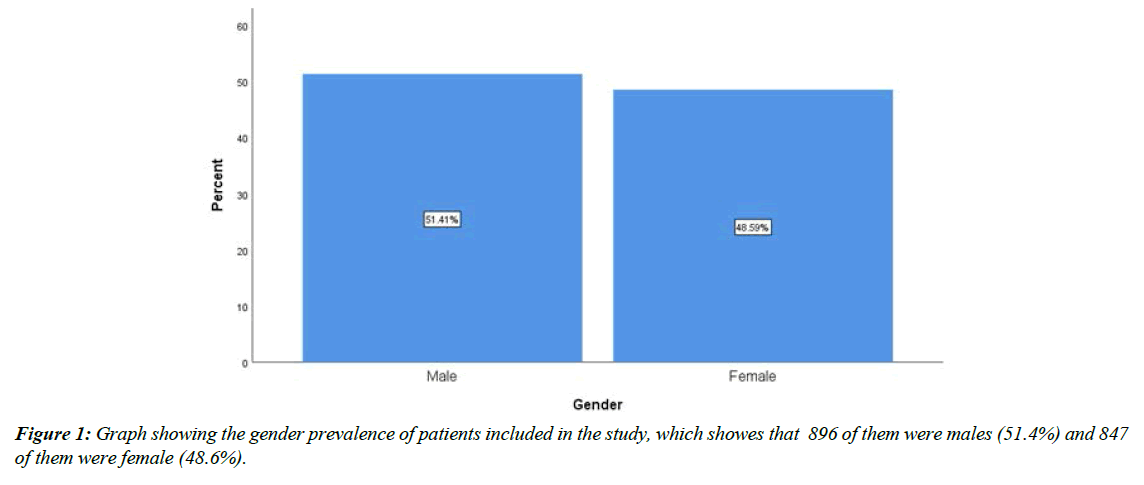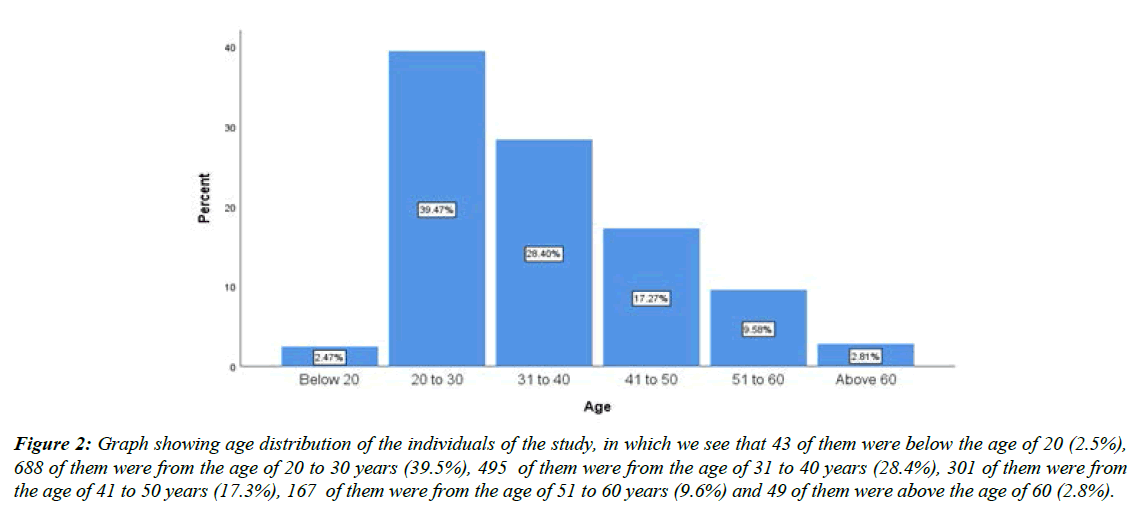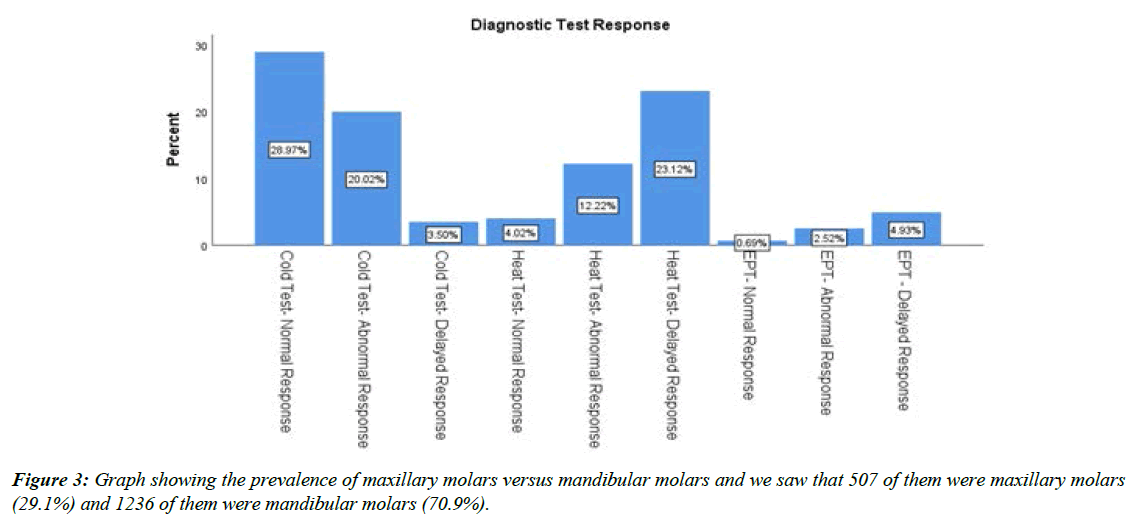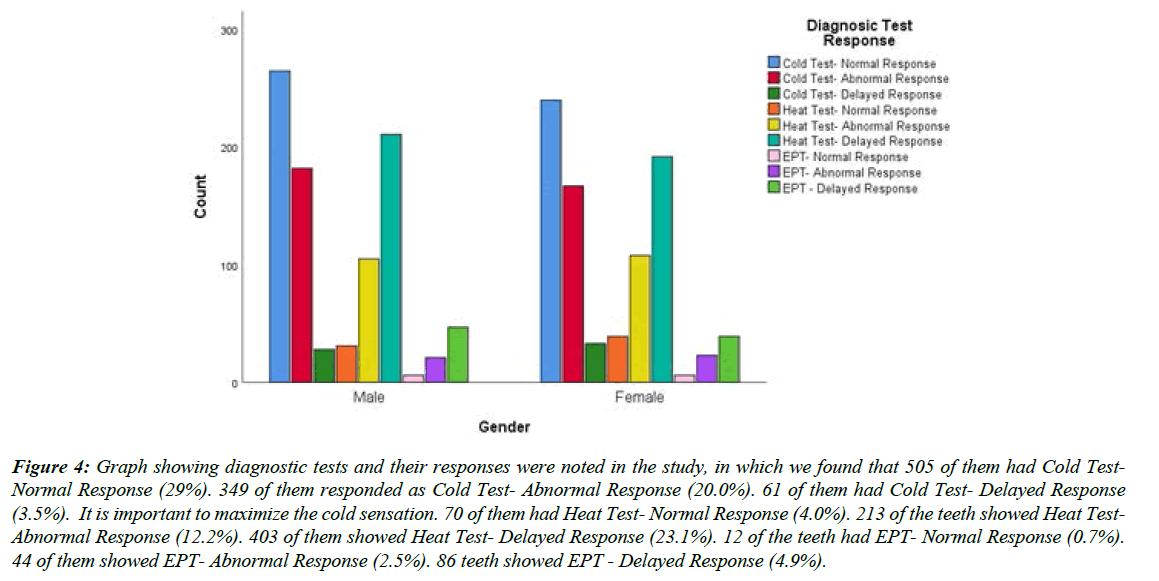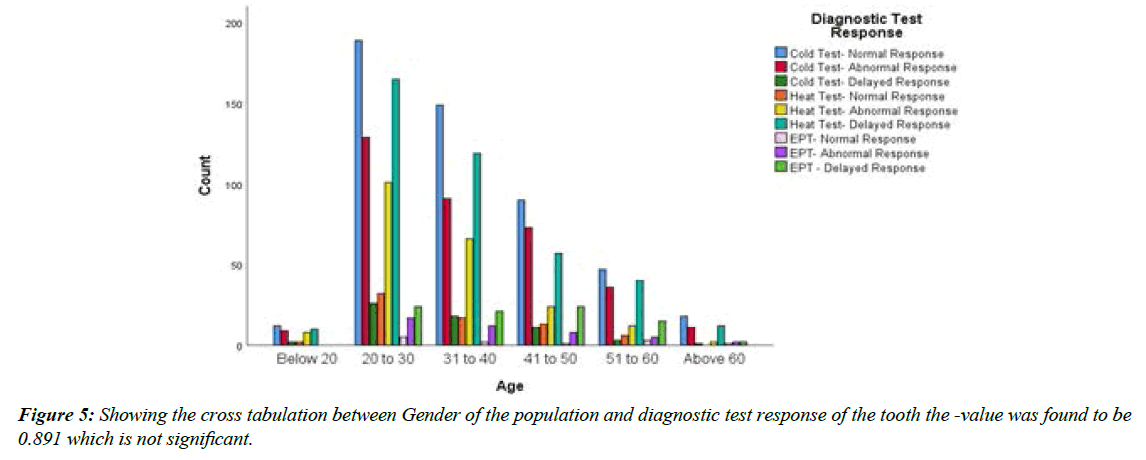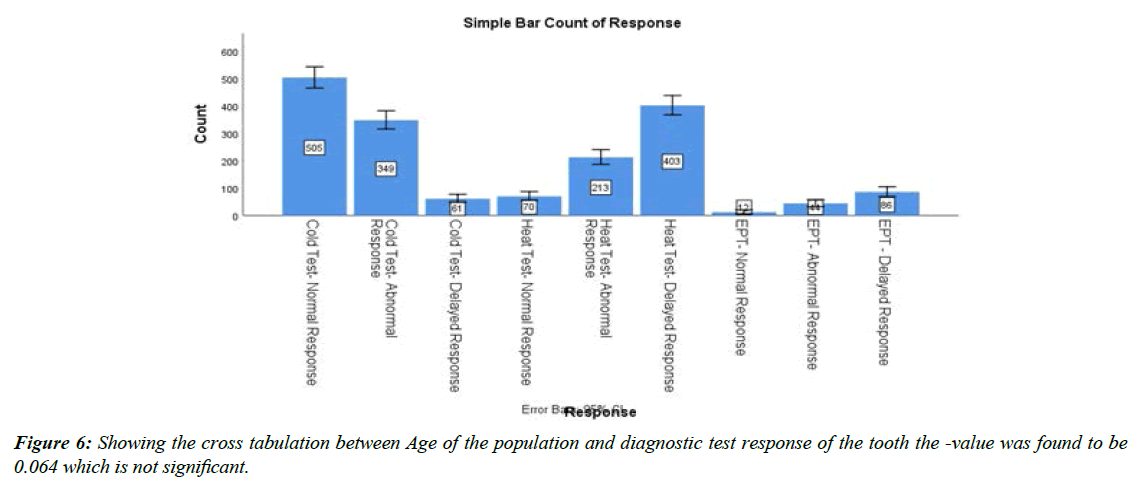Research Article - Journal of Clinical Dentistry and Oral Health (2022) Volume 6, Issue 2
Association of diagnostic test and type of response in multi-visit molar RCT
Babu BV, Sugumaran S*
Department of Conservative Dentistry and Endodontics, Saveetha Dental College and Hospitals, Saveetha Institute of Medical and Technical Sciences, Saveetha University, Chennai, India
- *Corresponding Author:
- Babu BV
Department of Conservative Dentistry and Endodontics
Saveetha Dental College and Hospitals
Saveetha Institute of Medical and Technical Sciences
Saveetha University, Chennai, India
E-mail: surendars.sdc@saveetha.com
Received: 23-Feb-2022, Manuscript No. AACDOH-22-52399; Editor assigned: 25-Feb-2022, PreQC No. AACDOH-22-52399(PQ); Reviewed: 11-Mar-2022, QC No. AACDOH-22-52399; Revised: 14-Mar-2022, Manuscript No. AACDOH-22-52399(R); Published: 21-Mar-2022, DOI:10.35841/aacdoh-6.2.106
Citation: Babu BV, Sugumaran S. Association of diagnostic test and type of response in multi-visit molar RCT. J Clin Dent Oral Health. 2022;6(2):106
Abstract
Introduction: Endodontic diagnostic tests are important for treatment planning. The diagnostic evaluation consists of several basic tests like palpation, percussion, periodontal probing, thermal testing- heat and cold and electrical pulp testing. The most rigorous method for evaluating the effectiveness and accuracy of diagnostic tests is by comparing the responses to each test during endodontic single visit root canal treatments. Materials and Method: A cross sectional retrospective study of, with a study population of 1743 patients visiting Saveetha Dental College and Hospital who had been treated with multi visit molar RCT, their diagnostic test responses were noted for them. The data was tabulated and analysed. SPSS by IBM was used for data analysis The Statistical test used was the Chi Square test. Results: From the collected data of 1743 teeth undergoing multi visit RCT and underwent diagnostic test response we see that 896 of them were males (51.4%). 688 of them were from the age of 20 to 30 years (39.5%) which is the most common age group of caries and has a good success rate for root canal treatment. Most common affected tooth was mandibular molars i.e. 1236 (70.9%). Commonly Cold Test showed Normal Response (29%) and Heat Test showed Delayed Response (23.1%). Conclusion: From the study we conclude that males are most commonly affected from caries, mandibular molar are the teeth that are more susceptible to caries than maxillary molar. Cold test and heat test were the most common type of test conducted out of which cold test normal response and heat test delayed response is the most common type of response.
Keywords
Multivisit, Molar, RCT, Diagnostic test, Response.
Introduction
Endodontic treatments used to take multiple visits to complete, with one of the main reasons for this being that it requires a considerable amount of time to complete the treatment [1]. Though multiple visit root canal treatments are well accepted, the concept of single visit root canal treatment was described in the early 1880s [2]. The most important first step in establishing a diagnosis is a thorough history of symptoms because many things patients tell you are important for reaching a diagnosis. Along with that advanced diagnostic tests help arrive at a better treatment planning.
Endodontic treatment used to take multiple visits to complete, with one of the main reasons for this being that it requires a considerable amount of time to complete the treatment. Though sometimes mechanical instrumentation alone may not be sufficient to remove bacteria and necrotic tissue from root canals owing to the complex anatomy [3,4].
Dental pulp tests are investigations that provide valuable diagnostic and treatment planning information to the dental clinician [5].
Pulp vitality testing
Assessment of the pulp’s blood supply: Pulp tissue may have an adequate vascular supply, but is not necessarily innervated [6]. Hence, most of the current pulp testing modalities do not directly assess the pulp vascularity and this is exemplified by clinical observations that traumatized teeth can have no response to a stimulus (such as cold) for a period of time following injury [7].
Pulp sensibility testing: assessment of the pulp’s sensory response: Sensibility is defined as the ability to respond to a stimulus, and hence this is an accurate and appropriate term for the typical and common clinical pulp tests such as thermal and electric tests given that they do not detect or measure blood supply to the dental pulp [8].
Pulp Sensitivity: Condition of the Pulp Being Very Responsive to a Stimulus: Thermal and electric pulp tests are not sensitivity tests although they can be used as sensitivity tests when attempting to diagnose a tooth with pulpitis since such teeth are more responsive than normal.
The three types of responses can be summarised as follows.
(i) The pulp is deemed normal when there is a response to the stimulus provided by the sensibility test and this response is not pronounced or exaggerated, and it does not linger.
(ii) Pulpitis is present when there is an exaggerated response that produces pain. Pulpitis can be considered as reversible or irreversible, depending on the severity of pain and whether the pain lingers or not. Typically mild pain of short duration is considered to indicate reversible pulpitis while severe pain that lingers indicates irreversible pulpitis [9].
(iii) The absence of responses to sensibility tests is usually associated with the likelihood of pulp necrosis, the tooth is pulpless, or has had previous root canal therapy [10].
Our team has extensive knowledge and research experience that has translate into high quality publications [10-29].
Objective
The aim of the study was to assess various diagnostic test responses in multi visit molar RCT.
Materials and Methods
Study design
A prevalence study.
Study setting
OPD Department in a private dental institution in Chennai.
Study size
1743 outpatients attending the OPD department.
Sampling and scheduling
Owing to the nature of the study design and setting, a convenience sampling method was used, and the data was collected.
Survey instrument
An online platform called DIAS was used to collect the data and the data of patients undergoing trans alveolar extraction was tabulated and analyzed.
Inclusion and Exclusion criteria
All those who underwent multi visit molar RCT in Saveetha Dental College and Hospital were included in the study. Patients who were below the age of 18 were not included in the study.
Ethical clearance
Prior to the study, ethical clearance was obtained from the institution ethical committee of Saveetha University.
Statistical analysis
The collected data was tabulated in excel and were then imported to SPSS by IBM software, (version 25). Descriptive statistics were done using frequency and percentage. Inferential statistics were done using the Chi-square test. Interpretation was based on a p value less than 0.05, which was considered statistically significant. Comparisons were done between independent variables like age, gender, occupation and knowledge, attitude, practice responses by the participants.
Results and Discussion
From the collected data of 1743 teeth undergoing multi visit RCT and underwent diagnostic test response we see that 896 of them were males (51.4%) and 847 of them were female (48.6%). In a study conducted by Monica Antony showed Male study population was 50.71% and the female population was 49.29%, this correlates to the current study that males are prone to caries. In another study conducted by John R Lukacs shoed among the Guanches, corrected tooth-count carries rates for females (8.8%, 158/1,790) are approximately twice the frequency of caries among males (4.5%, 68/1,498) this does not correlate with the study [30]. We also tabulated the age distribution of the individuals of the study, in which we see that 43 of them were below the age of 20 (2.5%), 688 of them were from the age of 20 to 30 years (39.5%), 495 of them were from the age of 31 to 40 years (28.4%), 301 of them were from the age of 41 to 50 years (17.3%), 167 of them were from the age of 51 to 60 years (9.6%) and 49 of them were above the age of 60 (2.8%). In a study conducted by Blerim Kamberi showed that the prevalence of caries for the whole study was 72.80%, and it decreased with age: 18–34 years (88.80%), 34–44 years (77.90%), 45–64 years (65.50%), 65–74 years (42.40%), and 75+ years (20.90%) (Figures 1 to Figure 6) [31].
Figure 2: Graph showing age distribution of the individuals of the study, in which we see that 43 of them were below the age of 20 (2.5%), 688 of them were from the age of 20 to 30 years (39.5%), 495 of them were from the age of 31 to 40 years (28.4%), 301 of them were from the age of 41 to 50 years (17.3%), 167 of them were from the age of 51 to 60 years (9.6%) and 49 of them were above the age of 60 (2.8%).
Figure 4: Graph showing diagnostic tests and their responses were noted in the study, in which we found that 505 of them had Cold Test-Normal Response (29%). 349 of them responded as Cold Test- Abnormal Response (20.0%). 61 of them had Cold Test- Delayed Response (3.5%). It is important to maximize the cold sensation. 70 of them had Heat Test- Normal Response (4.0%). 213 of the teeth showed Heat Test-Abnormal Response (12.2%). 403 of them showed Heat Test- Delayed Response (23.1%). 12 of the teeth had EPT- Normal Response (0.7%). 44 of them showed EPT- Abnormal Response (2.5%). 86 teeth showed EPT - Delayed Response (4.9%).
From the study we also found the prevalence of maxillary molars versus mandibular molars and we saw that 507 of them were maxillary molars (29.1%) and 1236 of them were mandibular molars (70.9%). The various diagnostic tests and their responses were noted in the study. In which we found that 505 of them had Cold Test- Normal Response (29%). 349 of them responded as Cold Test- Abnormal Response (20.0%). 61 of them had Cold Test- Delayed Response (3.5%). It is important to maximize the cold sensation. It is recommended that you test the tooth by spraying a fluffed cotton pellet held in a metal forceps and placing it on the buccal surface. The diagnostic test results can be altered by the presence of pulp stones and if the tooth had enamel loss due to remineralization [32]. 70 of them had Heat Test- Normal Response (4.0%). 213 of the teeth showed Heat Test- Abnormal Response (12.2%). Thermal tests were most used as diagnostic tests of which cold tests seemed more accurate. 59.96% of the time a cold test was used. They had greater accuracy, were more sensitive and CO2 was feasible and available [33]. 403 of them showed Heat Test- Delayed Response (23.1%). 12 of the teeth had EPTNormal Response (0.7%). 44 of them showed EPT- Abnormal Response (2.5%). 86 teeth showed EPT - Delayed Response (4.9%). According to a study conducted by Lin et al. Electrical pulp testing though they were used 20.40% of the times they were not accurate enough to differentiate vital from non-vital pulp [34]. The electrical pulp test is helpful when natural tooth structure is available and the results of the thermal tests are inconclusive. The EPT cannot be used on restorations and is not reliable when placed too close to the gingiva. Ideally, the area should be isolated and the tooth dries [35].
Conclusion
From the study we conclude that males are most commonly affected from caries, mandibular molar are the teeth that are more susceptible to caries than maxillary molar. Cold test and heat test were the most common type of test conducted out of which cold test normal response and heat test delayed response is the most common type of response.
Acknowledgements
We acknowledge Saveetha Dental College for all the help and support.
Conflict of Interest
The authors declare no conflict of interest.
Source of Funding
The present project is supported by
Saveetha Dental College and Hospitals, Saveetha Institute of Medical and Technical Science, Saveetha University, India.
Geetha Foundations and Flat Promoters.
References
- Wong AW, Zhang C, Chu CH. A systematic review of nonsurgical single-visit versus multiple-visit endodontic treatment. Clin Cosmet Investig Dent. 2014;6:45.
- Wong AW, Tsang CS, Zhang S, et al. Treatment outcomes of single-visit versus multiple-visit non-surgical endodontic therapy: a randomised clinical trial. BMC Oral Health. 2015;15(1):1-1.
- Siddique R, Sureshbabu NM, Somasundaram J, et al. Qualitative and quantitative analysis of precipitate formation following interaction of chlorhexidine with sodium hypochlorite, neem, and tulsi. J Cons Dent: JCD. 2019;22(1):40.
- Rajakeerthi R, Nivedhitha MS. Natural Product as the Storage medium for an avulsed tooth–A Systematic Review. Cumhuriyet Dental J. 2019;22(2):249-56.
- Rowe AH, Ford TP. The assessment of pulpal vitality. Int Endo J. 1990;23(2):77-83.
- Johnson JV. Evaluation of teeth vitality after subapical osteotomy. J. Oral Surg.1969;27:256-7.
- Bhaskar SN, Rappaport HM. Dental vitality tests and pulp status. J Am Dental Ass 1973;86(2):409-11.
- Mosby. Mosby’s Pocket Dictionary of Medicine, Nursing & Health Professions - E-Book. Elsevier Health Sciences; 2016;1488.
- Bender IB. Reversible and irreversible painful pulpitides: diagnosis and treatment. Aus Endo J. 2000 ;26(1):10-4.
- Abbott PV, Yu C. A clinical classification of the status of the pulp and the root canal system. Aus Dental J. 2007;52:17-31.
- PradeepKumar AR, Shemesh H, Nivedhitha MS, et al. Diagnosis of vertical root fractures by cone-beam computed tomography in root-filled teeth with confirmation by direct visualization: a systematic review and meta-analysis. J Endo. 2021;47(8):1198-214.
- Chakraborty T, Jamal RF, Battineni G, et al. A review of prolonged post-COVID-19 symptoms and their implications on dental management. Int J Enviro Res Public Health. 2021;18(10):5131.
- Muthukrishnan L. Nanotechnology for cleaner leather production: a review. Enviro Chem Lett. 2021;19(3):2527-49.
- Teja KV, Ramesh S. Is a filled lateral canal–A sign of superiority?. J Dental Sci. 2020;15(4):562.
- Narendran K, MS N, Sarvanan A. Synthesis, Characterization, Free Radical Scavenging and Cytotoxic Activities of Phenylvilangin, a Substituted Dimer of Embelin. Ind J Pharmac Sci. 2020;82(5):909-12.
- Reddy P, Krithikadatta J, Srinivasan V, et al. Dental caries profile and associated risk factors among adolescent school children in an urban South-Indian city. Oral Health Prev Dent. 2020;18(1):379-86.
- Sawant K, Pawar AM, Banga KS, et al. Dentinal Microcracks after Root Canal Instrumentation Using Instruments Manufactured with Different NiTi Alloys and the SAF System: A Systematic Review. App Sci. 2021;11(11):4984.
- Bhavikatti SK, Karobari MI, Zainuddin SL, et al. Investigating the Antioxidant and Cytocompatibility of Mimusops elengi Linn Extract over Human Gingival Fibroblast Cells. Int J Enviro Res Public Hea. 2021;18(13):7162.
- Karobari MI, Basheer SN, Sayed FR, et al. An In Vitro Stereomicroscopic Evaluation of Bioactivity between Neo MTA Plus, Pro Root MTA, BIODENTINE & Glass Ionomer Cement Using Dye Penetration Method. Mat. 2021;14(12):3159.
- Rohit Singh T, Ezhilarasan D. Ethanolic extract of Lagerstroemia Speciosa (L.) Pers., induces apoptosis and cell cycle arrest in HepG2 cells. Nutr Cancer. 2020;72(1):146-56.
- Ezhilarasan D. MicroRNA interplay between hepatic stellate cell quiescence and activation. Euro J Pharmacol. 2020;885:173507.
- Romera A, Peredpaya S, Shparyk Y, et al. Bevacizumab biosimilar BEVZ92 versus reference bevacizumab in combination with FOLFOX or FOLFIRI as first-line treatment for metastatic colorectal cancer: a multicentre, open-label, randomised controlled trial. Lancet Gastroenterol Hepatol. 2018;3(12):845-55.
- Raj R K. ß-Sitosterol-assisted silver nanoparticles activates Nrf2 and triggers mitochondrial apoptosis via oxidative stress in human hepatocellular cancer cell line. J Biomed Mat Res Part A. 2020;108(9):1899-908.
- Vijayashree Priyadharsini J. In silico validation of the non-antibiotic drugs acetaminophen and ibuprofen as antibacterial agents against red complex pathogens. J Periodontol. 2019;90(12):1441-8.
- Priyadharsini JV, Girija AS, Paramasivam A. In silico analysis of virulence genes in an emerging dental pathogen A. baumannii and related species. Archiv Oral Biol. 2018;94:93-8.
- Uma Maheswari TN, Nivedhitha MS, Ramani P. Expression profile of salivary micro RNA-21 and 31 in oral potentially malignant disorders. Braz Oral Res. 2020;34.
- Gudipaneni RK, Alam MK, Patil SR, et al. Measurement of the maximum occlusal bite force and its relation to the caries spectrum of first permanent molars in early permanent dentition. J Clini Pediatr Dent. 2020;44(6):423-8.
- Chaturvedula BB, Muthukrishnan A, Bhuvaraghan A, et al. Dens invaginatus: a review and orthodontic implications. Br Dent J. 2021;230(6):345-50.
- Kanniah P, Radhamani J, Chelliah P, et al. Green synthesis of multifaceted silver nanoparticles using the flower extract of Aerva lanata and evaluation of its biological and environmental applications. Chem Select. 2020;5(7):2322-31.
- Lukacs JR, Largaespada LL. Explaining sex differences in dental caries prevalence: Saliva, hormones, and “life-history” etiologies. Am J Hum Biol. 2006;18(4):540-55.
- Kamberi B, Koçani F, Begzati A, et al. Prevalence of dental caries in Kosovar adult population. Int J Dent. 2016;2016.
- Rajendran R, Kunjusankaran RN, Sandhya R, et al. Comparative evaluation of remineralizing potential of a paste containing bioactive glass and a topical cream containing casein phosphopeptide-amorphous calcium phosphate: An in vitro study. Pesquisa brasileira em odontopediatria e clinica integrada. 2019;19.
- Chen E, Abbott PV. Dental pulp testing: a review. Int J Den. 2009;2009.
- Lin J, Chandler NP. Electric pulp testing: a review. Int End J. 2008;41(5):365-74.
- Mahalakshmi Nandakumar IN. Comparative evaluation of grape seed and cranberry extracts in preventing enamel erosion: An optical emission spectrometric analysis. J Cons Dent. 2018;21(5):516.
Indexed at, Google Scholar, Cross Ref
Indexed at, Google Scholar, Cross Ref
Indexed at, Google Scholar, Cross Ref
Indexed at, Google Scholar, Cross Ref
Indexed at, Google Scholar, Cross Ref
Indexed at, Google Scholar, Cross Ref
Indexed at, Google Scholar, Cross Ref
Indexed at, Google Scholar, Cross Ref
Indexed at, Google Scholar, Cross Ref
Indexing, Google Scholar, Cross Ref
Indexing, Google Scholar, Cross Ref
Indexing, Google Scholar, Cross Ref
Indexing, Google Scholar, Cross Ref
Indexing, Google Scholar, Cross Ref
Google Scholar, Cross Ref, Indexing
Indexing, Google Scholar, Cross Ref
Indexing, Google Scholar, Cross Ref
Indexing, Google Scholar, Cross Ref
Indexing, Google Scholar, Cross Ref
Indexing, Google Scholar, Cross Ref
Indexed at, Google Scholar, Cross Ref
